TIMS Online Presentations 2025
Our next TIMS Online Presentation will be on the 29th of November.
We warmly invite all members and friends of mills to our 6th Online Presentation of 2025. This time, our speaker will be Eddy de Saedeleer, a long-time TIMS member, who will present the plans for the TIMS Mid-Tour 2026, to be held in Belgium. The tour will be organised by Eddy and the Belgian TIMS members, who look forward to welcoming participants to explore the country’s exceptional milling heritage.
The proposed route will take participants through Flanders, covering both West Flanders and East Flanders (33 locations), as well as the Campine region in the provinces of Antwerp and Flemish Brabant (13 locations). The tour will also extend southward into the historic territories of the former County of Flanders - partly in Hainaut (Belgium) and partly in French Flanders (France), adding another seven sites. Remarkably, in some of these areas, elderly residents still speak the old Flemish language.
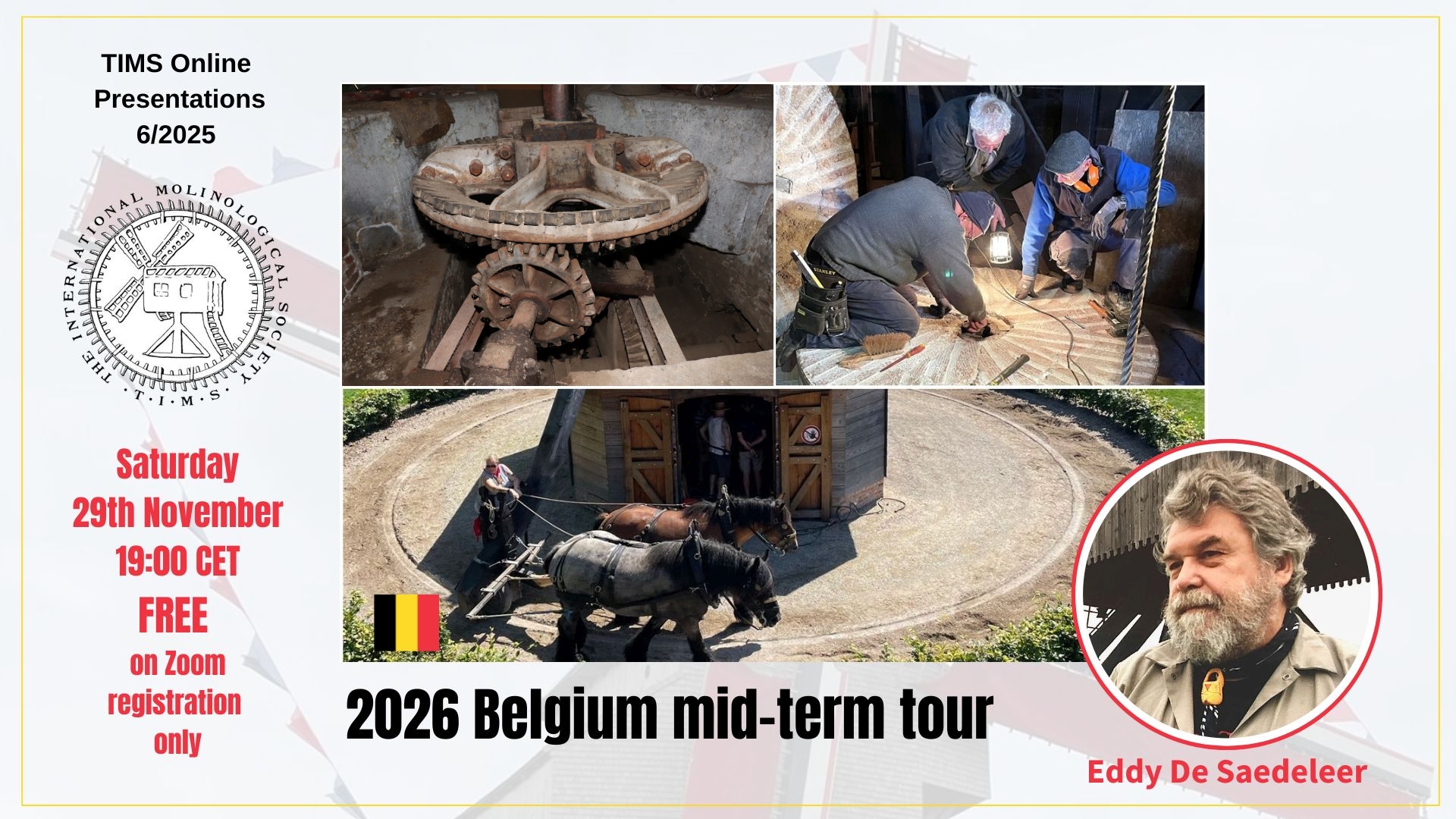
In total, 53 locations are planned: 49 mills and 4 photoshoots. The list includes 31 windmills, 13 watermills, 2 horse mills, 1 farm mill, and even a treadwheel once used by a dog. Participants will also encounter a statue of a miller and four museum collections.
Among the windmills, visitors will discover a fascinating variety — from postmills with open trestles or roundhouses, to stone mills on mounds or ground-sailed types, some featuring reefing stages. Highlights include postmills with traditional Flemish three-piece wooden stocks, examples with Van Bussel-type stocks, and even a postmill with multiple panniers (combuse). One of the featured mills is a war survivor, while another boasts a famous collar cap.
The watermills are equally diverse, including those with and without filling ponds. Some produce electricity (one dating back to World War I), while others still grind corn or press oil using edge runner stones. Visitors will see authentic gear wheel pits, paired stones, and even shade trees (tilia) planted to protect the waterwheels. One of the highlights will be a working tide mill near the River Scheldt, and the tour will conclude at a fully restored paper-making watermill.
Adding to the variety, the programme includes a farm jenever distillery, several operational horse mills, and small local museums that illustrate the region’s rich milling history. Participants might even have the chance to sample the unique “windmill beaker.”
Finally, the tour will celebrate the miller’s craft, now officially recognised in Flanders as part of the region’s intangible cultural heritage.
TIMS members will automatically receive the Zoom link to the Online Presentation by email.
When you are not a TIMS member you can register for the presentation. In that case please complete the form here:
https://forms.gle/gaj86MMJPRHkVz2u8
After registering, we will send you the Zoom link and further details closer to the event date.
Our previous TIMS Online Presentation "60 Years TIMS - What is TIMS all about?" was held on the 25th of October . . .
The video recording is available under this link.
Latest issue of E-News available for download
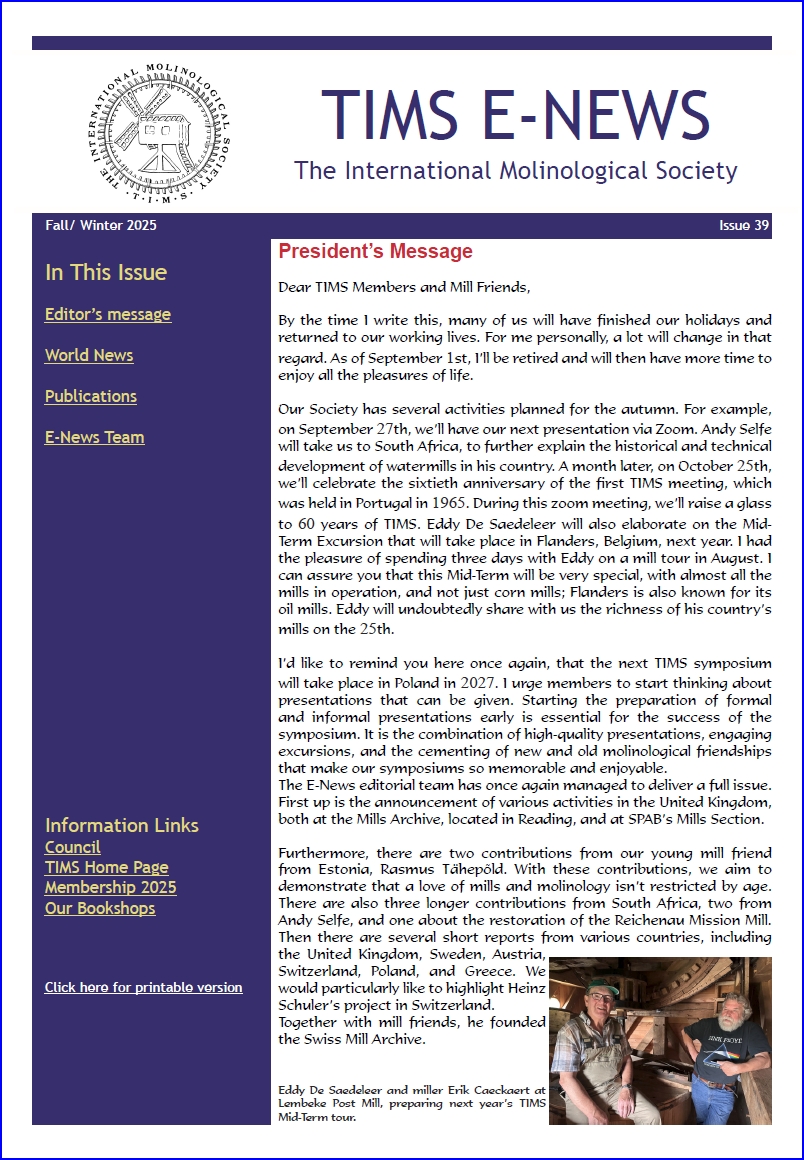
TIMS E-News Issue 39 (Fall 2025) is now available for download.
Enjoy reading!!
BM25 - Now available
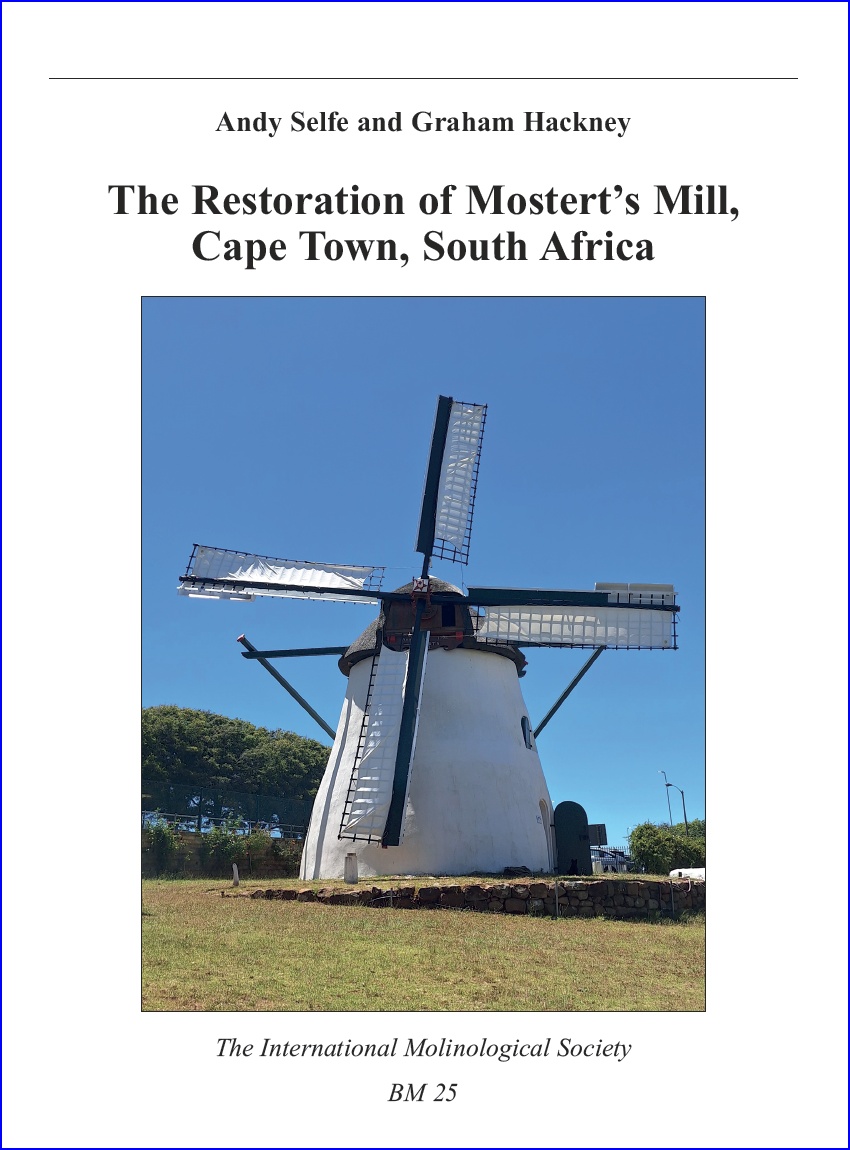
Good news! BM25 has been printed and sent out to all members. If you are not a member, and still would like to have the book, then best is just to become a member this year.
It is a wonderful production about the windmills in South Africa and more specific about the restoration of the Mostert's Mill in Cape Town.
Cape Town landmark, Mostert’s Mill burned down in the devastating wildfire of 18th April 2021 that did so much more damage. Andy Selfe (F68) had been involved in upgrades during the previous six years, the last being completed the afternoon before the fire. He was immediately put in charge of organising the re-making of all the working parts. He had recorded the processes before the fire, and continued doing so in the three years it took the team to bring the Mill back into working order.
Andy is our only South African TIMS member. He approached the Council suggesting that this restoration be used as the next in their ‘Bibliotheca Molinologica’ series. It was accepted and he was put in touch with Graham Hackney in the UK, editor of TIMS. Graham suggested including Mostert’s place in South Africa’s past, as well as the previous restorations which were carried out in 1935 and 1995, and anything else in between, including the upgrades.
This led to much research, including finding and translating from technical Dutch, the previous restoration reports in two periodicals. Much priceless material was received from the Mostert Family in connection with the early history, which Graham Hackney used to compile the early chapters on the background. In the description of the recent restoration it describes how Andy was able to recruit six other woodworking craftsmen to make the various components, according to their skills and machinery. The only parts to be imported were a pair of used French burr-stones and the sail cloths. Everything else was made in South Africa.
Funding came from private donations from ordinary citizens, overseas crowd-funding, as well as donations from City of Cape Town and Afriforum, but the majority came from the Rupert family, through their Historic Houses Foundation. Many people and firms made very generous donations in materials too.
BM25 is also being printed locally in South Africa for local mill friends. The book has 172 pages with many photos in full colour and is available through Friends of Mostert’s Mill, www.mostertsmill.co.za at the mill, at R350.00 including VAT, which includes a donation towards future upkeep. Chairman John Hammer can be contacted on the email address on the Membership page (where payment can be made) regarding collection. Otherwise Mostert’s Mill is open to the public every third Saturday of the month and copies can be bought there.
PL2027 - The 17th TIMS Symposium in Poland - First details
For your agenda: the 17th TIMS Symposium is planned to take place from the 10th to the 16th of May 2027, and the Post-Tour is planned from the 17th to the 21st of May.
The venue of the Symposium will be the National Museum of Agriculture and Food Industry in Szreniawa, which is about 14 km south of the city of Poznan. Poznan can easily be reached by car, and has excellent railway connections, as well as its own airport.
The Symposium hotel will be Hotel Delicjusz, about 3 km south west of the Symposium venue.
Videos of the 2024 TIMS Symposium in Portugal
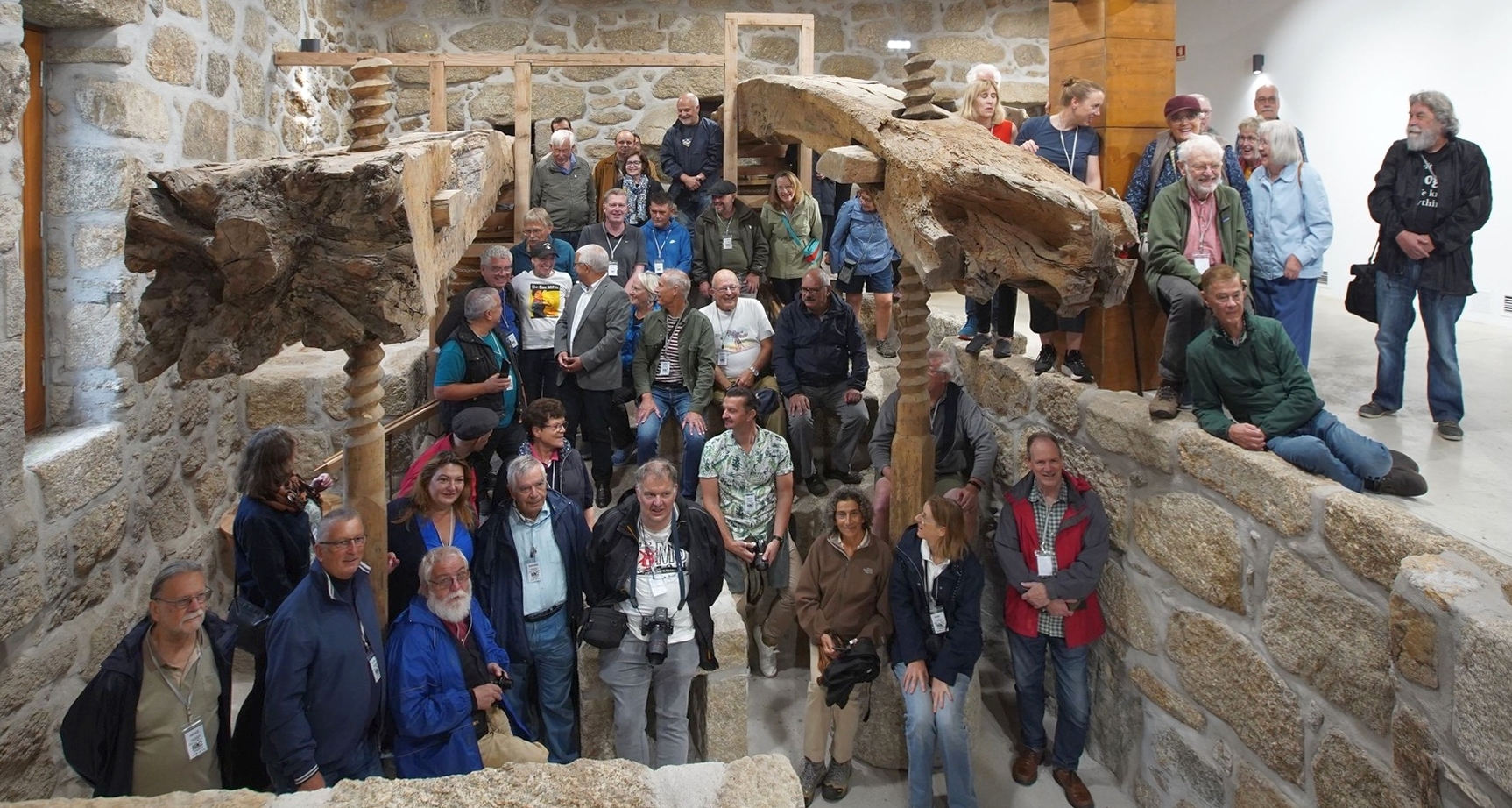
Group photo of the Sympsosium particpants
Videos by Gerald Bost:
TIMS Symposiun in Portugal Video 1
TIMS Symposiun in Portugal Video 2
TIMS Symposiun in Portugal Video 3
TIMS Symposiun in Portugal Video 4
New mill book by Radu Trifan
Our member Radu Trifan has issued a new book, a detailed inventory of the western Romanian province of Banat.
Have a look here
BM24 - Watermills within the eastern part of the Carpathian Basin
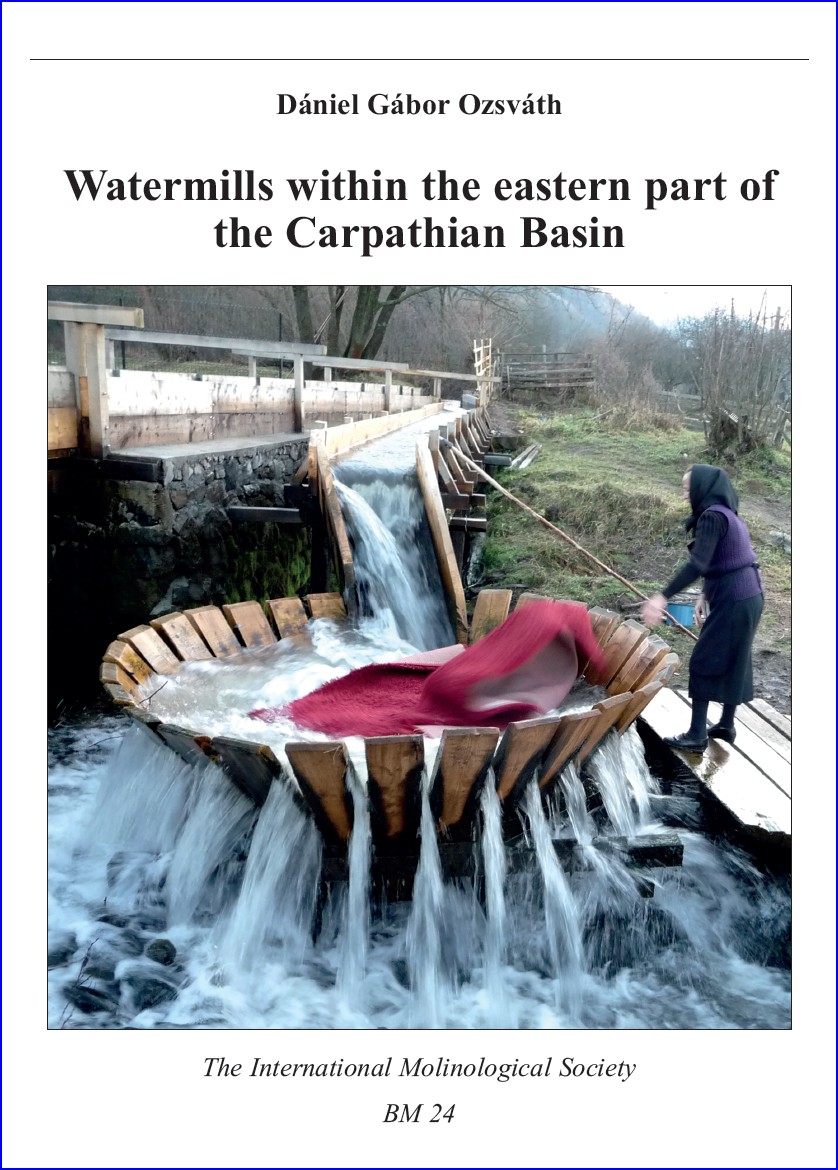
BM24 “Watermills within the eastern part of the Carpathian Basin” by Dániel Gábor Ozsváth is the latest publication in the series "Bibliotheca Molinologica".
Originally published in 2010 in hungarian, this english edition is fully updated with new material. The author recounts the history of this region and its watermills, spanning present-day Romania and Hungary. This was shaped by geo-political change; repeated attacks by the Turkish Empire led to 150 years of subjugation, then liberation by the Habsburgs and later assimilation into the Soviet bloc.
The necessary cooperation to keep mills running resulted in special water and mill laws. Then of course the changes in milling technology from the 19th century onwards; but, throughout, the mills kept going and now there still remain large numbers of small traditional working watermills situated on the many creeks.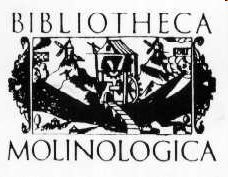
The building and machinery of traditional grain mills and their systems of water supply are explored. Then follows a chapter describing a local specialty, palinka mills, where mills share their buildings with distilleries. Moving on to industrial uses, we see how the power of water was used to saw wood and to process textiles, with detailed descriptions of fulling mills, and then crushing mills used to process ores.
The next two chapters look at the ownership of mills, by the church, the nobility and by the rural population. Mill communities held meetings to organize the operation and maintenance of mills, with powers to enforce regulations. Lastly, a look at how these social systems coped with changing borders and political systems of the 20th century.
The whole book counts 180 pages and is illustrated with photographs together with the locations of hundreds of surviving mills.
The publication can be ordered by sending an email to
BM23 - Greek Mills, From the Middle Byzantine Period to the 20th Century

"Greek Mills, From the Middle Byzantine Period to the 20th Century” is a publication in the series "Bibliotheca Molinologica".
It is as the title mentions, dealing with topics on any type of mill that has been recorded in the bibliography or still surviving in Greece the last 700 years but mainly in the last two centuries up to the early industrial period. It is in two volumes with a total of 700 pages with 92 articles written by 49 authors.
It took 6 years to materialize from the conception of the idea to its final publication involving people from all over Greece even in the remotest places.
There are more than 1200 pictures, plans and maps in colour to support and aid the reader to better understand the topics including a small map at the top of each article pinpointing the area where the subject is located to help the people who are unfamiliar with the geography of Greece.
The book is divided in the following parts:
Volume 1 - The social and cultural aspect of mills, Millstones, Man driven mills, Animal driven mills, Wind driven mills (tower mills), Wind driven mills (other mechanisms), Case studies,
Volume 2 - Water driven mills from medieval times up to the 18th century, Water driven mills from more recent times, Other water driven mechanisms, Early industrial mills.
The publication can be ordered by sending an email to



